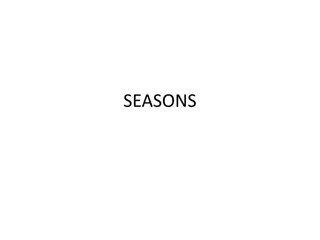Exploring Moon Phases and Lunar Basics
Delve into the fascinating world of moon phases and lunar phenomena. Learn about the different phases of the moon, why we see the moon, rotation, revolution, waxing, waning, and more.
Download Presentation

Please find below an Image/Link to download the presentation.
The content on the website is provided AS IS for your information and personal use only. It may not be sold, licensed, or shared on other websites without obtaining consent from the author. Download presentation by click this link. If you encounter any issues during the download, it is possible that the publisher has removed the file from their server.
E N D
Presentation Transcript
Phases of the Moon and moon basics
Learning Objectives I can explain why the moon has phases. I can identify the 8 phases of the moon.
Satellites Satellites are natural or artificial bodies that revolve around larger bodies like planets. Except for Mercury and Venus, all of the planets have natural satellites.
Moon name and where it rises and sets The Earth has one moon. In latin the moon is called Luna. The moon rises in the east and sets in the west.
Why do we see the moon? The moon does not give off its own light. It is the light from sun reflecting off the surface of the moon that creates light. 50% of the moon is always lit up by the sun.
Rotation and Revolution? The moon (Luna) rotates and revolves at the same rate of 27.3 days.
Rotation Even though the moon rotates, the same side of the moon always faces the Earth. When you look down on the earth it rotates counterclockwise (prograde motion).
Moon Phases The different forms that the Moon takes in its appearance from Earth.
Why does the moon have phases? The revolution of the Moon around the Earth causes the Moon to appear to have phases. As the moon orbits Earth, its position in the sky changes which produces the different phases of the moon we see each month.
Waxing and Waning mean? Waxing means that the bright side is increasing. The right side is the bright side. Gets more sunlight on as the days go by (grows bigger in appearance). Waning means that the illuminated side is decreasing. Gets less sunlight on the moon as the days go by (grows slimmer in appearance).
Rotation/Revolution and Phase Cycle When the moon is closest to Earth, it is about 221,463 miles away. Like Earth, the moon rotates and revolve on its axis. Unlike Earth, the moon takes approximately 27.3 days to complete one rotation and revolution. It takes 29.5 days for one cycle of the phases. New moon to New moon.
8 Phases of the Moon New Moon Full Moon Waxing Crescent Waning Gibbous First Quarter or Half Moon Last Quarter or Half Moon Waxing Gibbous Waning Crescent
Phases of Moon Rap Song
New Moon The moon is not visible from Earth. The moon is between the Sun and the Earth. The dark side is facing us. This phase lasts one night.
Waxing Crescent Waxing means that the bright side is increasing. The right side is the bright side. Less than one half of the moon is illuminated. This phase includes any visible moon from a small sliver to almost half.
First Quarter or Half Moon The entire right side of the moon is illuminated. The moon looks like a half circle. The illuminated side is increasing. This phase only lasts one night.
Waxing Gibbous Gibbous means that more than one half is visible, but it is not quite full. This phase includes the night after the first quarter to the night before the full moon.
Full Moon The moon is full and bright. It looks like a large circle. The illuminated side is facing us. Only happens one night per lunation.
Waning Gibbous The moon appears more than half but not quite full. Waning means that the illuminated side is decreasing. The left side is the bright side.
Last Quarter or Half Moon Left Half of the moon is illuminated. The illuminated side is decreasing. This phase also only lasts for one night.
Waning Crescent Less than one half of the moon is illuminated. The moon will continue to become smaller and smaller.
Phases During Day and Night Night Quarter Full Gibbous Day Quarter New Crescent
Can See The Phases of the Moon Song
Main Theory on formation of Moon Widely Accepted Moon formed when a large impact upon the earth with another small planet ejected a large portion of the earth s mantle into space. This debris began to revolve around the Earth within a few hours of impact. Additional space debris began to join together to form the moon. As the moon cooled, additional impacts created deep basins and fractured the moons surface. Lunar lava flowed from those cracks and flooded the basins to for the lunar seas.
Other Theory on formation of moon Capture Theory Moon like a wondering body like an asteroid that formed elsewhere in the solar system and was captured by Earth s gravity as it passed by.
Other Theory on formation of moon Accretion Theory Moon was created slong with the Earth at its formation.
Other Theory on formation of moon Fission Theory Earth was spinning so fast that some material broke away and began to orbit the planet.
Moons basic composition The Earth s moon has a much lower density than the Earth itself. Much of the material on the moon has a composition similar to that of the Earth s mantle.
Moons basic composition? The rocks brought back by the apollo astronauts have hardly changed since the creation of the solar system leading scientists to believe that they and the solar system are 4.6 billion years old. By studying the rate of cratering on the moon s surface, scientists are able to estimate the age of any body to estimate how old its surface is-even without bringing back a rock sample.
Big Ideas The Earth s moon probably formed by a giant impact with another small planet that put a portion of the earth s mantle into space The moon s phases are caused by the moons orbit. At different times of the month, we view different amounts of sunlight on the moon because of the moon s position relative to the sun and the Earth


![get⚡[PDF]❤ Building Habitats on the Moon: Engineering Approaches to Lunar Settle](/thumb/21624/get-pdf-building-habitats-on-the-moon-engineering-approaches-to-lunar-settle.jpg)




















